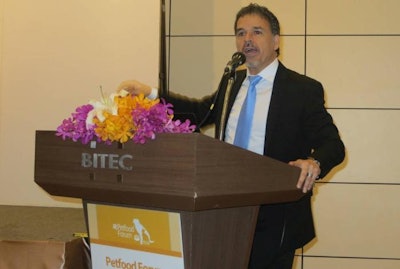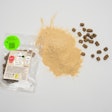
The pet food industry needs to have a “bigger conversation about pet food safety,” said Frank Yiannas, vice president of food safety for Walmart. “There are no silver bullets or easy answers.”
Yiannas delivered the opening session, “21st century pet food safety,” at Petfood Forum Asia 2016 on March 30 at the Bangkok International Trade and Exhibition Centre in Thailand. Held in conjunction with Victam Asia 2016, the fifth edition of the exclusive conference drew more than 120 pet food professionals from throughout Southeast Asia and other regions of the world. Yiannas gave them perspective on the current state of pet food safety with reasons for significant changes in the global food system, including:
- Food-borne surveillance. “Detection is outpacing prevention, making consumers think the wheels are coming off the bus” in terms of recalls and other food-related crises, Yiannas said. He cited a study Walmart conducted with its US customers showing that, four months after a food warning, they remember the country of origin more than the retailer, type of product or manufacturer.
- That’s because globalization happens so rapidly now, Yiannas said. One of his team members traced the origin of all the ingredients in one of the thousands of pet food products sold in Walmart stores, and found 56,000 “food miles” represented. “Pet food outbreaks and recalls are getting larger while the world is getting smaller,” Yiannas commented.
- Ingredients are the Achilles heel of food and pet food manufacturers, Yiannas believes, using the example of melamine in wheat gluten from China that affected many pet foods and human foods in 2007. To mitigate this risk, he recommended going beyond traceability to transparency, to completely understand the what, where and how of the ingredients you are using. Then, you must validate and verify their safety.
Other reasons Yiannas gave for the pressure on pet food safety included social media, humanization and consumer expectations. He issued a call to action to pet food manufacturers: avoid complacency (“easy to say, difficult to do”); learn from the mistakes of others; invest in prevention, which costs far less than handling recalls; adhere to globally recognized standards, such as those backed by the Global Food Safety Initiative; and create a pet food safety culture, not just a program.
Yiannas’ presentation at Petfood Forum Asia was followed by several others throughout the day-long conference, including an update on the global and Asia pet care markets, new research on gut microbiota in dogs and cats, a look at the fish-based ingredient supply chain, results of a study on what Thai consumers like in dry dog food, ways to ensure safety and palatability in pet food, innovations in automation of critical pet food production tasks and optimum vitamin nutrition for dogs and cats.
Petfood Forum Asia also featured several networking opportunities, including with sponsoring suppliers. The next edition of the conference will take place in 2018, again in Bangkok.

















